
Alstroemeriaceae is a family of flowering plants, with 254 known species in four genera, almost entirely native to the Americas, from Central America to southern South America. One species of Luzuriaga occurs in New Zealand, and the genus Drymophila is endemic to south-eastern Australia.
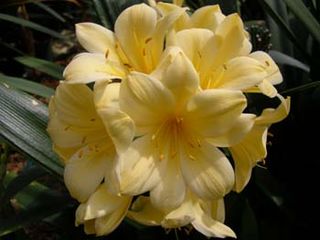
Clivia is a genus of monocot flowering plants native to southern Africa. They are from the family Amaryllidaceae, subfamily Amaryllidoideae. Common names are Natal lily or bush lily.
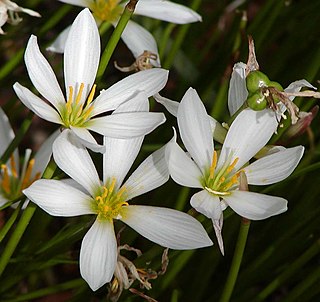
Zephyranthes is a genus of temperate and tropical plants in the Amaryllis family, subfamily Amaryllidoideae, native to the Western Hemisphere and widely cultivated as ornamentals. Following the expansion of the genus in 2019, which now includes the genera Habranthus and Sprekelia, there are about 200 recognized species, as well as numerous hybrids and cultivars. Common names for species in this genus include fairy lily, rainflower, zephyr lily, magic lily, Atamasco lily, and rain lily.

Lycoris is a genus of 13–20 species of flowering plants in the family Amaryllidaceae, subfamily Amaryllidoideae. They are native to eastern and southern Asia in China, Japan, southern Korea, northern Vietnam, northern Laos, northern Thailand, northern Burma, Nepal, northern Pakistan, Afghanistan, and eastern Iran. They were imported into North Carolina and now grow wild. In English they are also called hurricane lilies or cluster amaryllis. The genus shares the English name spider lily with two other related genera.
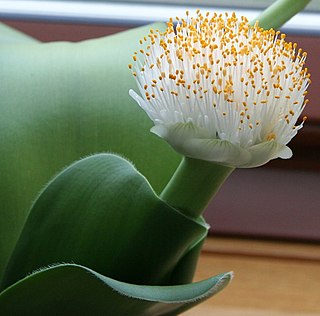
Haemanthus is a Southern African genus of flowering plants in the family Amaryllidaceae, subfamily Amaryllidoideae. Members of the genus are known as blood lily and paintbrush lily. There are some 22 known species, native to South Africa, Botswana, Namibia, Lesotho and Eswatini. About 15 species occur in the winter rainfall region of Namaqualand and the Western Cape, the remainder being found in the summer rainfall region, with one species Haemanthus albiflos occurring in both regions.

Eucrosia is a genus of herbaceous, perennial and bulbous plants in the Amaryllis family distributed from Ecuador to Peru. The name is derived from the Greek eu, beautiful, and krossos, a fringe, referring to the long stamens. As circumscribed in 2020, the genus contains six species. Phaedranassa and Rauhia are the genera most closely related to Eucrosia.

Strumaria is a genus of African plants in Amaryllis family, subfamily Amaryllidoideae. The genus is known in nature only from South Africa, Lesotho and Namibia. Almost all species flower in the autumn and are cultivated as ornamental bulbous plants.

Scadoxus is a genus of African and Arabian plants in the Amaryllis family, subfamily Amaryllidoideae. The English names blood lily or blood flower are used for some of the species. The genus has close affinities with Haemanthus. Species of Scadoxus are grown as ornamental plants for their brilliantly coloured flowers, either in containers or in the ground in frost-free climates. Although some species have been used in traditional medicine, they contain poisonous alkaloids.
Habranthus (copperlily) was a formerly recognized genus of tender herbaceous flowering bulbs in the subfamily Amaryllidoideae of the family Amaryllidaceae. It is now included within a more broadly circumscribed genus Zephyranthes. The genus was first identified by pioneering bulb enthusiast William Herbert in 1824.

Proiphys is a genus of herbaceous, perennial and bulbous plants in the family Amaryllidaceae, subfamily Amaryllidoideae. It includes 5 accepted species that are native to Southeast Asia, Papuasia, and Australia.

Boophone is a small genus of herbaceous, perennial and bulbous plants in the Amaryllis family It consists of two confirmed species distributed across South Africa to Kenya and Uganda. It is closely related to Crossyne, a genus whose species have prostrate leaves. They are drought tolerant but not cold-hardy, and are very poisonous to livestock.

Apodolirion is a genus of herbaceous, perennial and bulbous plants in the Amaryllis family. It consists of 6 species distributed in South Africa. The name Apodolirion comes from the Greek and means "stemless flower" and describes the almost sessile flowers of these species.

Rhodophiala was a genus of herbaceous, perennial and bulbous plants in the Amaryllis family. It consisted of about 30 South American species distributed in southern Brazil, Argentina, and, specially, in Chile. Most of the species are known colloquially as añañuca. It has now been submerged in Zephyranthes.
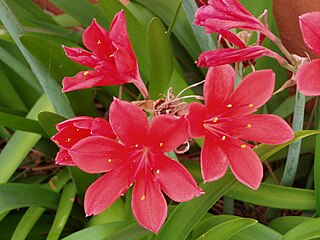
Cyrtanthus is a genus of perennial, herbaceous and bulbous plants in the family Amaryllidaceae, subfamily Amaryllidoideae.
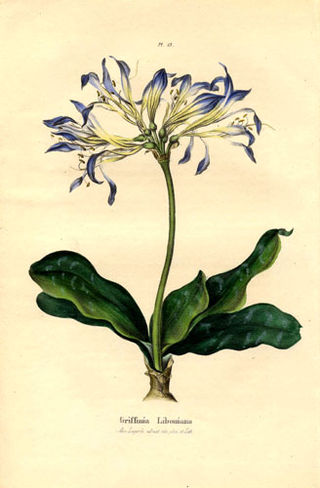
The tribe Griffineae includes 3 genera with 22 species from South America which are actually endemic to Brazil. A typical character of the representatives of the tribe are the flowers - They are with blue or lilac color collected into an umbel. Only the members of this tribe and the genus Lycoris are able to form flowers with such color in the whole subfamily Amaryllidoideae of Amaryllidaceae. The plants in this group are typical perennial flowers which are producing bulbs. The leaves are green, with elliptical form in the most of the cases but in some members as in Worsleya they are sword-shaped.

The Amaryllidaceae are a family of herbaceous, mainly perennial and bulbous flowering plants in the monocot order Asparagales. The family takes its name from the genus Amaryllis and is commonly known as the amaryllis family. The leaves are usually linear, and the flowers are usually bisexual and symmetrical, arranged in umbels on the stem. The petals and sepals are undifferentiated as tepals, which may be fused at the base into a floral tube. Some also display a corona. Allyl sulfide compounds produce the characteristic odour of the onion subfamily (Allioideae).
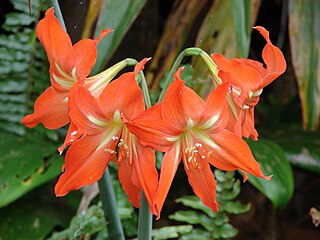
Hippeastreae is a tribe of plants belonging to the subfamily Amaryllidoideae of the Amaryllis family (Amaryllidaceae). Species in this tribe are distributed in South America. Flowers are large and showy, zygomorphic, with the stamens in varying lengths, inflorescence bracts are often fused basally. The seeds are flattened, winged or D-shaped. Reported basic chromosome numbers are x= 8-13, 17, and higher. All the species in this tribe present a remarkable aesthetic interest and horticultural value.

Amaryllidoideae is a subfamily of monocot flowering plants in the family Amaryllidaceae, order Asparagales. The most recent APG classification, APG III, takes a broad view of the Amaryllidaceae, which then has three subfamilies, one of which is Amaryllidoideae, and the others are Allioideae and Agapanthoideae. The subfamily consists of about seventy genera, with over eight hundred species, and a worldwide distribution.

Strumariinae is one of four subtribes within the tribe Amaryllideae, found in southern Africa.

Cliviinae is a small subtribe of Haemantheae, and therefore within the African clades of Amaryllidoideae. It consists of two genera, Clivia, and Cryptostephanus.


















